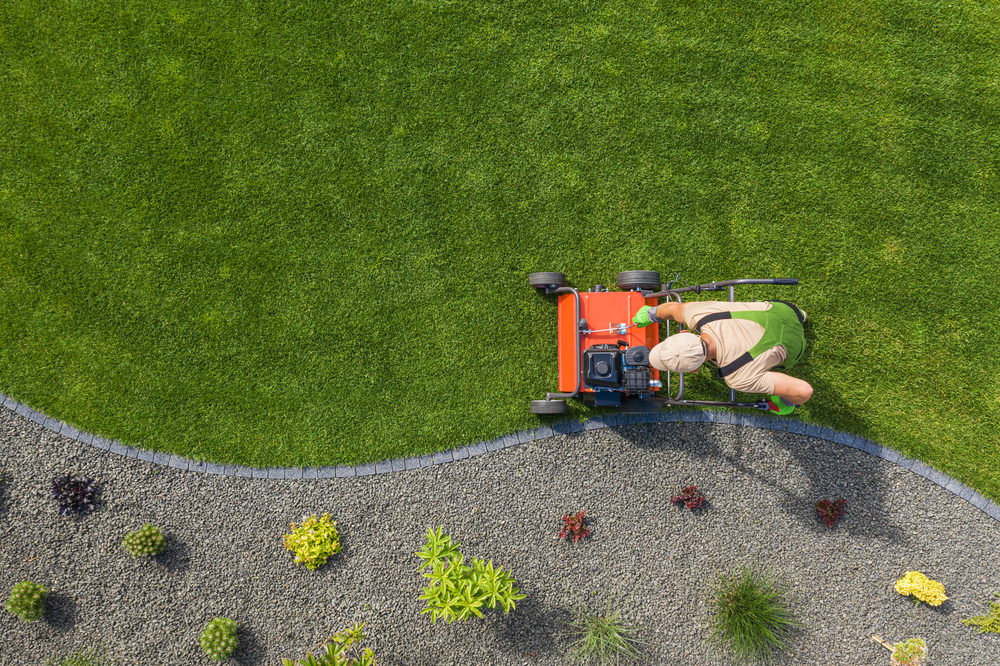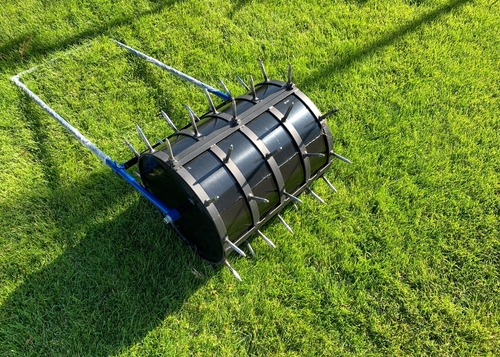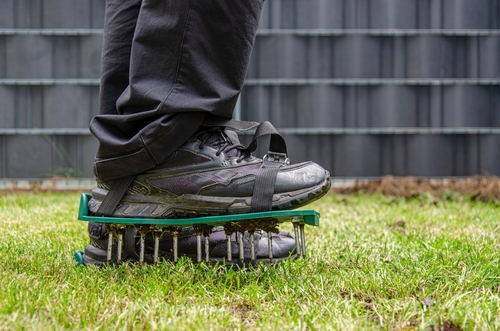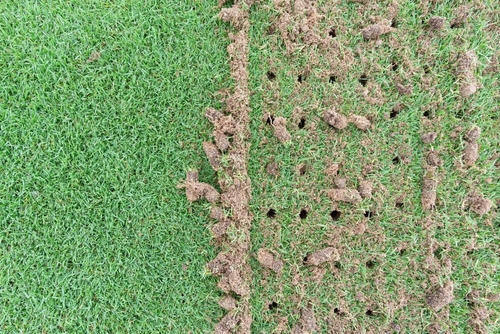
A lush, thriving lawn requires a bit of effort, especially in Decatur, IL, where dense clay soils and constant foot traffic are common challenges. Compacted soil squeezes roots, blocks water, and locks away vital nutrients, leaving lawns patchy and weak. The fix? Lawn core aeration. By opening up the soil with small holes, aeration gives roots room to grow while letting in the air, water, and nutrients they’re starving for. The result: a stronger, greener, healthier lawn.
But with a range of tools available, it’s important to know which ones will give you the best results – and whether it’s better to tackle it yourself or call in the experts. Let’s take a closer look.
What equipment do I need to aerate my lawn?
Before you even begin, having the right tools for aerating lawns is key. Without them, you could end up wasting time, damaging your lawn, or not getting the results you want. So, what do you need to get started?

- Lawn aerator: Core aerators, also known as plug aerators, are the best option for lawn aeration, and we’ll go into more detail about the different types below.
- Lawnmower: It’s important to mow your grass a bit shorter before aerating. This ensures that the tines or spikes can penetrate the soil without hitting tall grass.
- Garden hose and sprinkler: A deep watering a day or two before aeration is crucial. Moist soil helps the aerator’s tines move more easily through the soil, especially in Illinois’s clay-heavy earth.
- Markers or flags: If you’ve got sprinklers, irrigation lines, or any other underground systems, be sure to mark them so you don’t accidentally damage them while aerating.
- Gloves and sturdy shoes: Aeration can be a messy and strenuous task. Protect your hands and feet so you can work comfortably and safely.
- Optional extras: Grass seed and fertilizer. After aeration, it’s the perfect time to overseed and fertilize your lawn. Don’t worry about the soil plugs left behind – they’ll break down and naturally improve your lawn’s soil.
Skipping any of these steps can lead to a less-than-ideal lawn or potentially damage your equipment. So, make sure you’ve got everything you need before you begin!
What is the best tool for aerating a lawn?
Now that you know what you need to prepare, let’s talk about what options are actually worth your time. Not all aerators are created equal, and the right one for you will depend on your lawn’s unique needs. Different tools work better in different conditions, so let’s take a closer look:
Core/Plug Aerators
Whether you’re using a manual aerator for lawns, a walk-behind machine, or a tow-behind attachment for larger yards in Decatur and surrounding areas, these really get the job done. Professionals swear by them because they target the core issue – compaction. While other solutions can offer some benefits, core aerators stand out for making the biggest impact on your lawn’s overall vitality.
Best use case: If your soil is heavily compacted, or if you have clay-heavy soil, these aerator machines are the most effective choice.
Limitations: Requires some effort or specialized equipment, but the long-term benefits make it well worth the investment.
Spike Aerators
Spike aerators are often cheaper and simpler to use, but they don’t tackle compaction in the same way. They use spikes to poke holes into the soil, which allows for some air and water penetration. However, they don’t remove any soil, and over time, the action of pushing the soil aside can actually make compaction worse. This is especially true for spike aerator shoes, which sound promising but rarely provide meaningful results.
Best use case: Suitable for lawns with light compaction or sandy soil where soil displacement isn’t a concern.
Limitations: Not effective for clay-heavy or compacted soils. Can worsen soil compaction in the long run.
Slicing Aerators
Slicing aerators use rotating blades to slice through the soil, creating grooves that allow for better water movement. While they can help break up thatch, they don’t remove any soil, so they’re not effective at addressing compaction. These tools are ideal if your main concern is thatch buildup, but if your lawn is compacted, you’ll need to combine this method with others for maximum benefit.
Best use case: Ideal for lawns with thick thatch layers or for overseeding.
Limitations: Not a solution for compaction; better when paired with core aeration for best results.
Liquid Aerators
Liquid aerators are soil conditioners that are sprayed over your lawn. These products work by breaking down compacted soil gradually over time, which can improve soil structure. However, they don’t provide the immediate results that core aeration does. For heavily compacted soil, liquid aerators are not a substitute for physical aeration methods.
Best use case: Good for improving soil structure over time in lawns with mild compaction.
Limitations: Works slowly and is not effective for serious soil compaction issues.
Can I aerate my lawn myself?
When it comes to aerating your lawn, you’ve got two main options: tackle the job yourself or call in the Decatur pros. Both routes have their perks, but it’s important to weigh the pros and cons before deciding which is the best fit for your lawn and your schedule.

DIY aeration
Pros:
- Cost-effective: If you already own an aerator or can rent one, DIY aeration can save you a fair bit of cash.
- Satisfying: There’s something rewarding about rolling up your sleeves and improving your lawn with your own hands.
- Total control: You get to decide when, how often, and where to aerate. You can really zero in on those hard-to-reach spots.
Cons:
- Physically demanding: Aeration can be tough work, especially if you’re using a hand or walk-behind aerator. Be prepared to put in some muscle.
- Risk of mistakes: If you get the soil moisture wrong, use the wrong equipment, or aerate at the wrong time, you could do more harm than good. Not to mention, it’s easy to miss areas or not get the depth right.
- Time-consuming: If you’ve got a large lawn, aeration will definitely take up a big chunk of your weekend.
Professional aeration
Pros:
- Expert knowledge: True professionals know exactly when and how to aerate for optimal results. They’ll assess your lawn’s unique needs and make sure they’re using the right equipment at the right time.
- Top-notch equipment: Pros use commercial-grade gear that’s much more effective than what most homeowners can rent or buy.
Convenience: Let the experts handle it so you don’t have to break a sweat or sacrifice your weekend.
Cons:
- Upfront cost: While hiring a pro can be more expensive than DIY, the difference might not be as large once you factor in equipment rental and the time you’d spend doing it yourself.
Ultimately, it comes down to your budget, time, and how hands-on you want to be with your lawn care.

Who in Decatur offers expert lawn core aeration?
Tired of guessing what your lawn needs? We’ve been helping Decatur homeowners for years, and we know how the area’s soil and weather can throw your yard off track. From season to season, we’re here to handle the unique challenges your lawn faces. Whether you’re unsure about the right time to aerate or wondering if overseeding is a good idea, we’re ready to give you expert advice and the care your lawn deserves. Give us a call today!